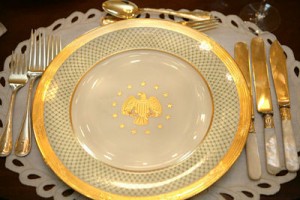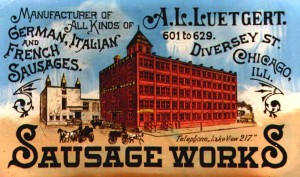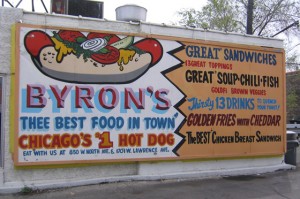4646 North Hermitage Avenue
The modest house you are looking at was an early home of the poet Carl Sandburg.
Sandburg moved to Chicago in 1912, living in a second floor apartment in this building. He was a reporter for the Chicago Daily News and a member of All Saints Episcopal Church. Here he composed among the best known of his poems, Chicago, published in 1915.
He lived here with his wife Lillian and his daughter Margaret, then two years old.
On locating the apartment Sandburg wrote Lillian he had found “our really, truly home.”
The Sandburgs moved to Maywood in 1914.
The building itself has been ‘marred,’ according to a 1994 writer, by poor choices in window replacement, aluminum siding and the removal of the front porch.

This undated photo from the Sulzer Library’s Ravenswood Lake View Historical collection shows the Sandburg home some years ago.
It was built between 1891 and 1894.
Listen to Roy Trumbull read the poem Chicago
Chicago
Hog Butcher for the World,
Tool Maker, Stacker of Wheat,
Player with Railroads and the Nation’s Freight Handler;
Stormy, husky, brawling,
City of the Big Shoulders:
They tell me you are wicked and I believe them, for I have seen your painted women under the gas lamps luring the farm boys.
And they tell me you are crooked and I answer: Yes, it is true I have seen the gunman kill and go free to kill again.
And they tell me you are brutal and my reply is: On the faces of women and children I have seen the marks of wanton hunger.
And having answered so I turn once more to those who sneer at this my city, and I give them back the sneer and say to them:
Come and show me another city with lifted head singing so proud to be alive and coarse and strong and cunning.
Flinging magnetic curses amid the toil of piling job on job, here is a tall bold slugger set vivid against the little soft cities;
Fierce as a dog with tongue lapping for action, cunning as a savage pitted against the wilderness,
Bareheaded,
Shoveling,
Wrecking,
Planning,
Building, breaking, rebuilding,
Under the smoke, dust all over his mouth, laughing with white teeth,
Under the terrible burden of destiny laughing as a young man laughs,
Laughing even as an ignorant fighter laughs who has never lost a battle,
Bragging and laughing that under his wrist is the pulse, and under his ribs the heart of the people, Laughing!
Laughing the stormy, husky, brawling laughter of Youth, half-naked, sweating, proud to be Hog Butcher, Tool Maker, Stacker of Wheat, Player with Railroads and Freight Handler to the Nation.
 
WALKING DIRECTIONS TO NEXT LOCATION
Continue the tour to 4611 North Hermitage Avenue.
- Continue south along Hermitage for about 364′. The building will be on your left, across the street and before the next corner.
- Click the ‘Continue the Tour’ button below when you’ve reached your destination.









